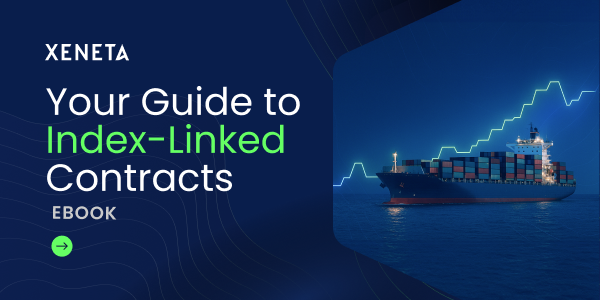If you are a business preparing a budget ahead of tendering for your next long term ocean container shipping contract, where do you start given the massive supply chain volatility during 2025 in the wake of US tariffs and trade wars?
In a hypothetical scenario where your current long term contract entered validity on 1 January 2025 following a tender in Q4 2024, you are likely facing a very different scenario ahead of negotiations in Q4 this year for your next agreement starting on 1 January 2026.
This blog will use this scenario to demonstrate the strategies shippers can adopt to identify opportunities – and risk – by assessing the contrasting landscape across four of the world’s ocean container trades:
- Far East to North Europe
- Far East to South America East Coast
- Far East to US West Coast
- North Europe to Far East
Compare your current rate with today’s market
A good starting point is to look at the current rate level in the long term market and compare it to your existing agreement, even if that means (for now) ignoring volatility in spot and long term rates in the intervening months. To be clear, the spot market will still be an important factor in your long term contract tender strategy, as this blog will demonstrate.
Once you have this direct comparison, you can begin to use data to understand how these rates are likely to develop ahead of your next tender and the reduction (or increase) you could expect compared to your current contract.
|
|
Av. long term rate 1 Jan 2025 |
Av. long term rate 19 Aug 2025 |
Difference |
|
Far East to North Europe |
2815 |
2180 |
-23% |
|
Far East to South America East Coast |
4077 |
2420 |
-41% |
|
Far East to US West Coast |
3307 |
2000 |
-40% |
|
North Europe to Far East |
258 |
152 |
-41% |
In the case of Far East to North Europe, a shipper is looking at a reduction of 23% compared to their existing agreement if they locked in at today’s long term market average.
Even in a conservative scenario with rates rising 10% from today to 1 January 2026, shippers would still be getting a 15% reduction in rates compared to 1 January this year.
On the other three trades, the decline is even steeper with long term rates down more than 40% compared to 1 January 2025. This doesn’t tell the whole story however, because while there may be opportunity for greater savings where long term rates have fallen harder, there can also be more risk.
Spot rates will impact long term market
The forecast for the remainder of 2025 across the world’s major trades is further decline in spot rates, which will put further downward pressure on long term rates. A declining spot market during negotiations in Q4 will impact market sentiment and make it more difficult for carriers to argue for higher long term rates.
|
|
Av. spot rate 1 Jan 2025 |
Av. spot rate 19 Aug 2025 |
Difference |
|
Far East to North Europe |
4844 |
3102 |
-36% |
|
Far East to South America East Coast |
6070 |
3982 |
-34% |
|
Far East to US West Coast |
5843 |
1920 |
-67% |
|
North Europe to Far East |
353 |
265 |
-25% |
In the case of Far East to North Europe, a shipper may be looking for a reduction in the new contract rate even greater than 23% given the expected downward trend for the remainder of 2025. It is a similar story across the other two fronthaul trades, in particular the Far East to US West Coast where spot rates are already down 67% compared to 1 January.
In the case of the backhaul from North Europe to Far East, given average long term rates are already record low, there is limited room for more significant declines. This highlights the need to understand these dynamics across the trades a shipper uses.
Where there is opportunity there is also risk
It must be stressed, this blog comes with the heaviest of caveats given the geo-political climate and black swan events hitting global supply chains with increasing regularity.
During black swan events, carriers prioritize containers being moved on spiraling spot rates. This means some shippers risk being unable to move their goods against a long-term contract if their rates are at the bottom end of the market. If they want to keep supply chains moving during the black swan, they may be forced to pay elevated spot rates or hit with big surcharges.
The spread between the spot rate and long term rate becomes extremely important. The higher the spread, the greater the risk, particularly for shippers with rates at the bottom end of the long term market.
|
Trade |
Spot-long spread 19 Aug 2025 |
|
Far East to North Europe |
922 |
|
Far East to South America East Coast |
1562 |
|
Far East to US West Coast |
-80 (spot lower than long) |
|
North Europe to Far East |
113 |
The table above casts the situation in a different light, in particular the risk of pushing for even lower long term rates.
A shipper may look at the long term rate decline of 41% into the South America East Coast and view this as an even bigger opportunity than the trade into North Europe where long term rates have decreased a lesser 23%.
However, the spot-long spread into the South America East Coast is already at USD 1562 per FEU. Pushing for even lower long term rates would potentially open this spread further – and therefore increase risk.
Note: it is likely that the spot-long spread on the South America East Coast trade will narrow by 1 January 2026 due to further declines in spot rates, but it is something a shipper should still factor in their strategy.
In the case of the US West Coast, average long term rates are down 40% compared to 1 January. With average spot rates now falling below long term rates on this trade, shippers could be forgiven for pushing even harder during the next tender negotiation.
But they should be careful how low they go…
Shippers have been caught out before
This could be a case of history repeating if shippers are not wise to the risk of chasing the bottom dollar in the new long term contract.
For example, on 1 October 2023, spot rates fell to USD 1712 per FEU on the trade from Far East to US West Coast. This was USD 163 below the average long term rate on the same day at USD 1875 per FEU, meaning shippers were looking for reductions during new contract negotiations.
Sound familiar?
Then the Red Sea escalated in December 2023 and by July 2025 average spot rates spiraled to USD 8010 per FEU. The spread between spot and long term rates was a massive USD 5645 per FEU, meaning those shippers who chased the bottom dollar in long term contract negotiations were heavily exposed.
Understand differences across trades
This blog is intended to share strategies for approaching tenders, but all trades behave differently and shippers must tailor their approach accordingly.
The backhaul trade from North Europe to Far East is included for this reason. The current average long term rate on this trade is record-low at just USD 152 per FEU (when terminal handling charges are excluded the rate is negative). Clearly there is little room for rates to fall further, but shippers can still use the situation to their advantage.
While rates may be low, carriers still value backhaul volumes. A shipper should be able to use volumes on a backhaul trade to strike a better rate or service levels when running their global tender.
Looking ahead
There are plenty of opportunities – and risk - for shippers in the upcoming tender seasons, but it requires an approach that balances financial savings against supply chain resilience.
For this reason, many shippers are now linking their new long term contract to the Xeneta index. This index—linked contract tracks the market against agreed thresholds, meaning the shipper benefits from a softening market, but is also protected from a spiraling spot-long spread in the event of another black swan.
%201.png)




.png?width=387&name=image%20(45).png)

